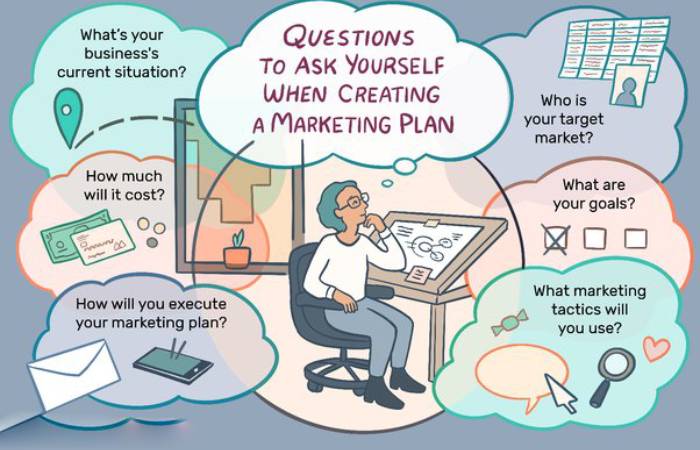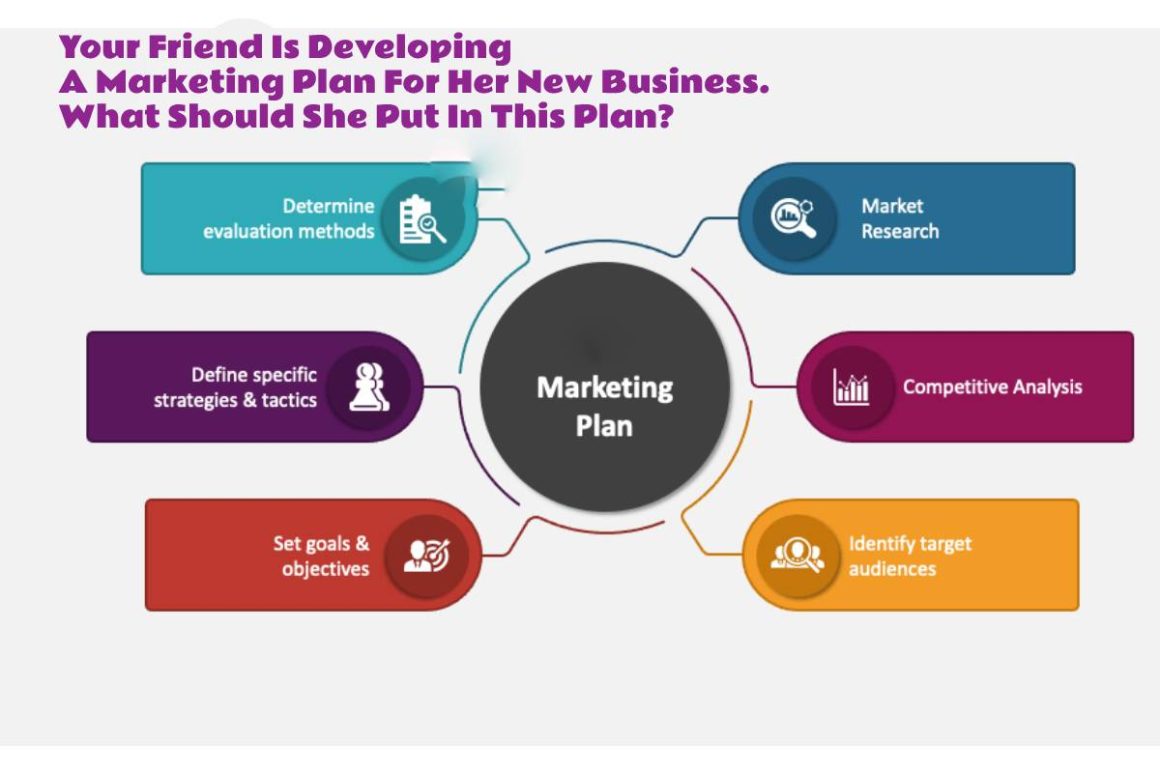Table of Contents
Your Friend Is Developing A Marketing Plan For Her New Business. What Should She Put In This Plan?
Your Friend Is Developing A Marketing Plan For Her New Business. What Should She Put In This Plan? A comprehensive marketing plan is crucial for guiding the growth and success of a new business. Here’s a breakdown of the essential components to include in your friend’s marketing plan:
- Executive Summary: This concise overview provides a high-level understanding of the business, target market, marketing objectives, and overall strategy.
- Situation Analysis: This section delves into the current market landscape, including industry trends, competitor analysis, and the business’s internal strengths and weaknesses.
- Target Market Definition: Clearly define the ideal customer base, including demographics, psychographics, buying behaviors, and online habits.
- Marketing Objectives: Establish specific, measurable, achievable, relevant, and time-bound (SMART) marketing goals aligned with the business’s objectives.
- Marketing Strategies: Outline the key strategies to achieve the marketing objectives, such as content marketing, social media marketing, SEO (search engine optimization), or paid advertising.
- Marketing Tactics: Develop detailed action plans for each strategy, including specific activities, timelines, and responsible individuals.
- Marketing Budget: Allocate a realistic budget for each marketing tactic, ensuring sufficient resources to execute the plan effectively.
- Marketing Metrics and Evaluation: Define key performance indicators (KPIs) to measure each marketing tactic’s success and evaluate the plan’s overall effectiveness.
- Marketing Timeline and Schedule: Create a comprehensive timeline for implementing the marketing plan, including milestones, deadlines, and task assignments.
- Contingency Plans: Identify potential risks or challenges impacting the marketing plan and develop contingency plans to address them effectively.
Remember, a marketing plan is a dynamic document that should be regularly reviewed, updated, and adapted as market conditions and business objectives evolve.
Which Statement Is The Best Description Of The Value Proposition? Your Friend Is Developing A Marketing Plan For Her New Business. What Should She Put In This Plan?

A value proposition is a brief statement that communicates the unique value a company or product offers to its customers. It explains why a customer should choose one product or service over another. The best description of a value proposition is:
A promise of value to be delivered by a company to its customers, highlighting the specific problem it solves, the advantages it provides, and why it is superior to its competitors’ alternatives.
A Strong Value Proposition Should Be:
- Clear and concise: Easily understood by the target audience.
- Unique and differentiated: Sets the product or service apart from competitors.
- Compelling and persuasive: Convinces customers that the product or service is worth their time and money.
- Focused on customer benefits: Emphasizes how the product or service solves customers’ problems or improves their lives.
Some Examples Of Strong Value Propositions:
- “Uber: Get a ride from anyone with a car.”
- “Airbnb: Find unique accommodations around the world.”
- “Dropbox: Keep your files safe, synced, and accessible from anywhere.”
- “Slack: Bring your team together with a single place for messaging, tools, and files.”
- “Squarespace: Build a beautiful website in minutes, even if you have no coding experience.”
Understanding The Cornerstones Of A Marketing Plan
A marketing plan serves several crucial purposes:
- Provides Direction: It guides the company’s marketing efforts, ensuring they are aligned with the overall business goals.
- Facilitates Informed Decisions: It helps make informed decisions about resource allocation, strategy development, and tactical execution.
- Improves Accountability: It establishes clear roles and responsibilities, enhancing accountability and tracking progress.
- Enables Adaptation: It allows for flexibility and adaptation to changing market conditions or business objectives.
- Enhances Success: A well-crafted marketing plan increases the likelihood of achieving marketing goals and overall business success.
In conclusion, a marketing plan is essential for any business seeking to effectively reach its target market, generate leads, and achieve its marketing objectives. By incorporating the critical cornerstones outlined above, companies can develop a comprehensive and strategic plan that drives growth and success.
Understanding Your Business And Target Market for Your Friend Is Developing A Marketing Plan For Her New Business. What Should She Put In This Plan?
Understanding your business and target market is essential for developing a successful marketing strategy. Here are some critical steps to understanding your business and target market:
- Define your business: Clearly articulate your business’s mission, vision, and values. Understand your unique selling proposition (USP) and how you differentiate yourself from competitors.
- Identify your target market: Define your ideal customer base by considering demographics, psychographics, and buying behaviors. Determine their location, age, gender, interests, lifestyle, and online habits.
- Understand your customer needs and pain points: Conduct market research to understand your target market’s unmet demands, challenges, and frustrations. Point out the problems your product or service can solve.
- Analyze your competitors: Research your competitors, including their products, services, pricing, marketing strategies, strengths, and weaknesses. Identify your competitive advantage.
- Develop buyer personas: generate detailed profiles of your target customers, including their demographics, psychographics, buying behaviors, and motivations.
- Map your customer journey: Understand the steps your ideal customers take from awareness to consideration to purchase and beyond. Identify touchpoints and opportunities to engage with them.
- Measure your marketing ROI: Set clear marketing goals and track metrics to compute the effectiveness of your marketing efforts. Analyze data to identify areas for improvement.
- Adapt and iterate: Regularly review your understanding of your business and target market as market conditions and customer preferences evolve. Adapt your marketing strategies accordingly.
- Seek feedback: Gather feedback from customers, potential customers, and industry experts to gain insights and refine your understanding.
By taking these steps, you can better understand your business market and the competitive landscape. This knowledge will empower you to develop effective marketing strategies that echo your ideal customers and drive business growth.
Identifying and Utilizing Marketing Tactics
Marketing tactics are businesses’ specific actions to achieve their marketing goals. Companies use the tools and techniques to reach their target audience and increase sales. Various marketing tactics are available, and the best mix for a particular business will depend on its target trade, budget, and goals.
The Most Common Marketing Tactics: for
Your Friend Is Developing A Marketing Plan For Her New Business. What Should She Put In This Plan?
- Content marketing: Creating and sharing valuable, in-tune content to attract and keep clearly defined customers and drive profitable customer action.
- Social media marketing: Using social media websites to join with target audiences, build brand awareness, and promote products or services.
- Email marketing: Sending targeted emails to subscribers to build relationships, nurture leads, and promote products or services.
- Pay-per-click (PPC) advertising: Placing ads on social media websites, search engines, and other websites, only paying when someone clicks on the ad.
- Public relations (PR): creating relationships with journalists and influencers to generate positive media coverage and enhance brand reputation.
- Affiliate marketing: Partnering with other businesses or creatures to enhance products or services in exchange for a commission.
- Influencer marketing: Partnering with influential individuals in a particular niche or industry to promote products or services to their followers.
- Event marketing: participating in events to connect with generate leads and potential customers and build brand awareness.
- Direct marketing: Sending targeted marketing messages to potential customers through email, direct mail, or phone calls.
Choosing the Right Marketing Tactics Your Friend Is Developing A Marketing Plan For Her New Business. What Should She Put In This Plan?
The best way to choose the right marketing tactics for your business is to start by understanding your target market and marketing goals. Once you know who you want to reach and what you want to achieve, you can research different tactics and choose the most likely effective ones.
Some Factors To Consider When Choosing Marketing Tactics:
- Target audience: What are your target market’s demographics, psychographics, and online habits?
- Budget: How much money do you have to allocate to marketing?
- Skills and expertise: Do you have the in-house skills and expertise to execute your chosen tactics?
- Competition: What are your competitors doing, and what seems to work for them?
Utilizing Marketing Tactics Effectively
Once you have chosen your marketing tactics, it is essential to use them effectively to achieve your goals. Here are some tips for utilizing marketing tactics effectively:
- Set clear goals and objectives: For each tactic, define what you need to achieve and how you will measure success.
- Invent a plan: Develop a detailed strategy for each tactic, including timelines, budgets, and responsible individuals.
- Execute consistently: Implement your plan consistently and monitor progress regularly.
- Measure and evaluate: Track critical metrics to measure the effectiveness of each tactic and make adjustments as needed.
- Adapt and evolve: Be prepared to adapt your tactics as your business, target market, and competitive landscape change.
Following these tips, you can effectively utilize marketing tactics to achieve your marketing goals and grow your business.
Crafting Effective Marketing Strategies To Your Friend Is Developing A Marketing Plan For Her New Business. What Should She Put In This Plan?

Effective marketing strategies are crucial for any business thriving in today’s competitive marketplace. A well-crafted plan can guide you to reach your target customers, generate leads, increase sales, and achieve your overall business objectives.
1. Define Your Target Audience:
- Consider demographics, psychographics, and buying behaviors to identify your ideal customer base.
- Understand their motivations, needs, and pain points to tailor your messaging and offerings accordingly.
2. Establish Clear Marketing Goals:
- Set SMART (Specific, Measurable, Achievable, Relevant, and Time-Bound) goals to align your marketing efforts with your business objectives.
- Define what you want to achieve, such as increasing brand awareness, generating leads, or boosting sales.
3. Conduct Market Research: Your Friend Is Developing A Marketing Plan For Her New Business. What Should She Put In This Plan?
- Analyze your industry, competitors, and target market to gain insights into market trends and competitive landscape.
- Identify opportunities to differentiate your brand and address unmet customer needs.
4. Develop Buyer Person as:
- Build detailed profiles of your ideal customers, including their demographics, interests, behaviors, and aspirations.
- Use these personas to guide your marketing decisions and content creation.
5. Select Appropriate Marketing Channels: Your Friend Is Developing A Marketing Plan For Her New Business. What Should She Put In This Plan?
- Select the marketing channels that best align with your target audience’s preferences and online behavior.
- Consider social media, content marketing, email marketing, search engine optimization (SEO), and paid advertising.
6. Develop a Compelling Value Proposition:
- Clearly articulate your product or service’s unique value to your target audience.
- Highlight how your offering solves their problems, improves their lives, or fulfills their desires.
7. Track and Measure Results:
- Establish key performance indicators (KPIs) to measure the effectiveness of your marketing strategies.
- Regularly monitor and analyze data to identify areas for improvement and optimize your campaigns.
8. Adapt and Evolve: Your Friend Is Developing A Marketing Plan For Her New Business. What Should She Put In This Plan?
- Be prepared to adapt your marketing strategies as market conditions, customer preferences, and technologies change.
- Stay informed about industry trends and embrace new gadgets and techniques to stay ahead of the competition.
9. Seek Expert Guidance:
- Consider consulting with marketing professionals or agencies to gain specialized expertise and insights.
- Leverage their experience to develop and execute effective marketing campaigns.
Effective marketing strategies are not static; they require continuous evaluation, refinement, and adaptation to ensure they remain relevant and achieve your business goals.
Conclusion
A comprehensive promoting arrangement serves as a capable apparatus for modern businesses, directing them through the complexities of the commercial center and moving them toward victory. By understanding your trade and target advertising, setting clear objectives, creating viable methodologies, utilizing suitable strategies, and measuring execution, you can harness the control of promoting to realize feasible development and make an enduring effect.


